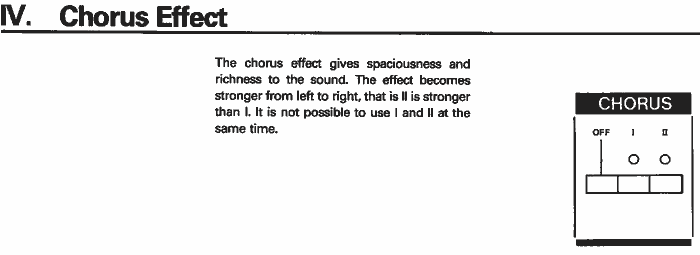Differences Between the JUNO-6, JUNO-60 and JUNO-106
It would appear there's a lot of misinformation about the differences of the JUNO-6, JUNO-60 and JUNO-106: both in terms of features and sound quality. I've combed through various sources: Discord, Gearspace, Vintage Synth Explorer, Reddit, YouTube (...) and they all seem to say incredible things either downplaying the differences in features or imagining differences in sound quality that aren't there.
I've compiled a chart highlighting all of the major differences between all three models, along with some brief commentary about it.
JUNO Chart Comparison
| Feature | JUNO-6 | JUNO-60 | JUNO-106 |
|---|---|---|---|
| Chorus Mode III* | Yes | Yes | No |
| PWM Assignable to Envelope Generator** | Yes | Yes | No |
| Integrated Arpeggiator | Yes | Yes | No |
| Continuous HPF*** | Yes | No | No |
| Portamento | No | No | Yes |
| Integrated MIDI | No | No | Yes |
| Integrated DCB**** | No | Yes | No |
| Patch Memory | No | Yes | Yes |
| Unison (Without Diagnostic Mode) | No | No | Yes |
| HPF Bass Boost (HPF = 0)***** | No | No | Yes |
*Chorus Mode III is engaged on a JUNO-6/60 by pressing both Chorus I and II and the same time. It adds a bit of chaotic panning which can totally be used for effects since when it comes to the JUNO series, you need every last bit of sound crafting due to how limited the architecture is. The JUNO-106 manual states that this feature is missing from it:

**This is a feature that often gets ignored (and I've seen some artists on YouTube laugh at it), however... it's VERY powerful for building pads because it allows the single oscillator to morph its character synchronized to the ADSR of the volume, and the results are quite stunning. Props to Kebu because he actually noticed this function and thought it was cute too ;)
***Curiously enough the JUNO-6 is the only one with a continuous HPF that's not notched to four values. I'm not really sure why the 60 and 106 have a notched HPF, but that does mean you get dramatically less sound sculpting. If I had to hazard a guess, I'm going to assume that they wanted to save some $$$ DAC and microcontroller complexity, as having more values than 4 on the HPF would be more expensive. But who knows, it's Roland and they could have just done it because they wanted to.
****With DCB you can pop on a simple DCB-to-MIDI from Valpower to get basic MIDI functionality, so it's not a total dealbreaker anymore.
*****This accounts for probably the biggest (actual) perceived change in sound when comparing the 106 against the 6/60. The architectural behaviour differences shouldn't be conflated with the fact the chorus and filter is the same.
Which is the Best?
I personally prefer the JUNO-60 because you get the most options for patch programming out of the box and can create sounds that are just not possible on the 106 unfortunately. And yeah there are mods like the JUNO-66 which give it all of the features of the 106 and more, but I actually like working around all of the JUNO-60's original limitations because it's both a part of the synthesizer's character and makes me think outside the box. Of course there might be someone else who prefers the HPF on the 106, so there's no right answer -- all three models give you the famous bucket brigade chorus and filter.
Because some of the patches can become quite complicated (in the sense that you have to REALLY carefully nudge the sliders for resonance programming, and just breathing on it will cause a major difference in sound), I would always choose the 106 or 60 over the 6, but again it comes down to preference.
Does the JUNO-106 Really Sound That Different?
There's a lot of hearsay claiming that the JUNO-60 and JUNO-106 have differences in noise of the chorus (depending on who you ask they can blame either one, lol). Or, people will say one sounds "warmer" than the other without providing any evidence via sound samples.
The JUNO-60 and JUNO-106 use the exact same bucket brigade ICs and calibration procedures. There is no difference. Both synthesizers also use DCOs: the magic in the JUNO series isn't the (rather bland) oscillators but the filter and chorus! And since both synthesizers use the exact same chorus and filter* neither is going to be 'warmer' or 'worse' than the other as far as sound is concerned.
In a blind test or even a final mix, it's going to be impossible tell the difference unless you leverage a feature that's exclusive to one of the models not present on the other.
- *Yeah the 106 uses the IR3109 filter on a surface mount package, but I don't think the surface mount technology changes the sound really. I've been listening to the original discreet BA662 circuit and it's almost identical to IR3109. If I do notice any differences as the filter design became more and more integrated over the years I'll update this section.
Both models do have some differences (especially regarding the bass on the low end as the HPF is different), but those differences don't mean that the chorus is sounding "warmer" on one or the other or that the filter is completely different because they're not.
Schematically Identical (Chorus/Filter)
To conclude, there are some differences with the envelope generators and the fact the 106 has bass boosting on HPF (technically all three have different HPFs as a result), and that will have an impact when programming certain sounds... but that's unrelated to the tonal qualities of the chorus and filter which are (schematically) identical.
Synthfighter has a very good comparison between the two (although I noticed YouTube has done some nasty things to the output, especially adding loads of artifacts in the chorus... but since they're BOTH subjected to that the comparison still stands so it's not really an issue):
For a baseline to contrast against the YouTube compression above, here's some crappy playing on my JUNO-60 and you'll probably hear how much better frequency response it has:
And there's also the Wikipedia recordings too:
Hopefully that clears it up for anyone wondering about the finer particulars.




